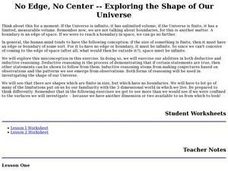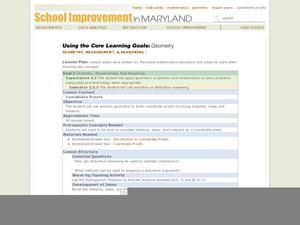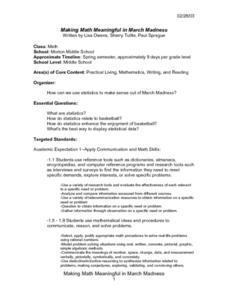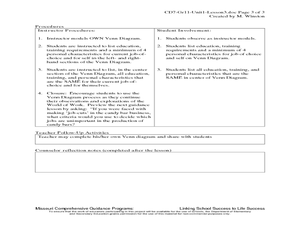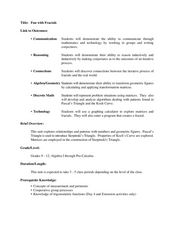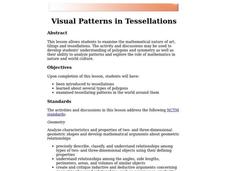Curated OER
No Edge, No Center -- Exploring the Shape of Our Universe
Students examine various "spaces" (including ones that are one-dimensional, two-dimensional, and three-dimensional). For each space, they will examine what it means to have or not have an edge, or to be finite or infinite.
Curated OER
What Does Respect Look Like in School?
Fourth graders discuss why everyone needs and wants to feel respected. As a class, they share what respect looks like and what disrespect looks like. They pretend they have to leave their most valued object with a secret agent and what...
Curated OER
Analyzing My Path to Success
Seventh graders review their graphs from the previous lesson about trends. Individually, they identify their personal strengths and weaknesses when it comes to being successful. To end the lesson, they use this information to write a...
Curated OER
Review and Revision of My Personal Plan of Study
Tenth graders make decisions, set goals, and take necessary action to achieve goals. They explore options and resources available to further develop personal education plans for life-long learning and develop questions and ideas to...
Curated OER
Evaluating and Revising the Personal Plan of Study
Eleventh graders register for standardized tests and attend post-secondary information meetings that meet individual needs as well as work on updating and revising their personal plans for their futures. They brainstorm if any changes in...
Curated OER
Coordinate Proofs
Students explore the concept of coordinate proofs. In this coordinate proofs lesson, students write coordinate proofs using properties of distance, slope, and midpoint. Students discuss why it is sometimes beneficial to double the...
Curated OER
Life...Bring It On!
Eighth graders write their name however they see fit on a poster board. Individually, they write down their strengths that relate to them making important decisions around their name. To end the lesson, they use magazines to find...
Curated OER
Ready to Remain Safe
Eighth graders discuss making the wrong decisions because of peer pressure and the consequences of those actions. As a class, they identify the positive and negative consequences based on a variety of scenerios. To end the lesson, they...
Curated OER
Angle Attributes and Measures
Seventh graders explore the concept of angles. In this angles lesson, 7th graders use protractors to measure angles. Students sing an angle song. Students discuss attributes of angles using a two-color plate manipulative.
Curated OER
Putting Your Best Foot Forward
Third graders measure their feet and their parents' feet, record data on computer-generated graphs, and calculate and record mean, median, and mode.
Curated OER
Fraction Equivalence
Fourth graders explore fractions. They compare different fractions using fraction bars. Students find equivalent fractions and they use fraction bars to visualize addition of fractions.
Curated OER
Making Math Meaningful in March Madness
Middle schoolers examine the statistics of March Madness, the college basketball tournament. They watch videotaped basketball games to collect data for further analysis using Word and Excel. They analyze the data in a variety of...
Curated OER
A Fortnight of Furlongs
Young scholars perform a webquest to research information about the horse industry. They look at economic and the cultural impact of the industry on Central Kentucky and then create a group presentation that addresses all essential...
Curated OER
Career Paths in My Community
First graders study career opportunities in their local community. In this career exploration instructional activity, 1st graders answer 'Who Am I?' questions and study career path posters. Students list the skills they've learned at...
Curated OER
Does my career fit me?
Young scholars create a venn diagram about the job they currently have and if they think it is what they should be doing. In this job lesson plan, students list education and job duties in a venn diagram and analyze if it is the correct...
Curated OER
Fun With Fractals
Young scholars use fractals to analyze nature. In this geometry lesson, students work in groups using technology and math to communicate. They identify where in the real world fractal can be seen.
Curated OER
Pythagorean Theorem
Students explore how the Pythagorean Theorem works and how to apply it.
Curated OER
United Nations Mini-Unit
Students demonstrate the ability to develop questions and ideas to initiate and refine research. They demonstrate the ability to conduct research and to answer questions and evaluate information and ideas. They design World Peace Flags.
Curated OER
Ancient Egyptian Culture
Fifth graders participate in a Webquest on Ancient Egypt. They identify clothing and jewelry, list the steps of mummification, decipher hieroglyphics, and complete a Travel Log.
Curated OER
Comparing Edible Communities
Students explore the components of a community by creating analogies between aspects of a community and ingredients within a recipe. They view and discuss pictures, write analogies, and generate a product from a recipe.
Curated OER
Visual Patterns in Tessellations
Learners explore tessellations as well as various types of polygon. Students examine tessellating patterns in the world around them. Learners examine tessellations by creating their own tessellations and completing the included worksheet.
Curated OER
Pythagorean Theorem
Learners are introduced to the Pythagorean theorem. They use three different activities that give students the opportuntiy to observe triangles, and use the Pythagorean theorem and practice different ways of determining areas of...
Curated OER
An Introduction to Quadrilaterals
Students explore different types of quadrilaterals. Students define the terminology used with quadrilaterals. They create particular quadrilaterals based on specific characteristics of the quadrilaterals using an online tool.
Curated OER
Post-Secondary Checklist
Twelfth graders answer the question what is next for them and identify how life is going to be different after high school. As a class, they share their life experiences in elementary and middle school and then predict how it might be...


